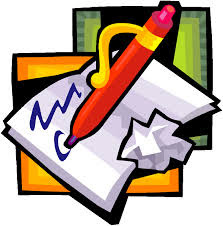
I must confess that in certain matters I am very conventional.
I still prefer my good old notebook over a laptop for writing meeting notes.
Nowadays the trend is to carry laptops or tablets and sometimes even a recorder (if permitted) for meetings.
A few days back, I read a very interesting article on what you miss when you take notes on your laptop.
The article was mainly for classroom lectures where one group of students were asked to take notes on their laptop and another group in their notebooks. Afterwards , there was a test on the lecture where the questions were a mix of factual-recall based as well as conceptual-application questions.
The test marks varied widely for the two groups.
It was found out that the group which took long hand notes scored significantly better in the conceptual questions as well as factual ones.
The group which took notes using laptops had long transcription like notes which was almost "verbatim" of whatever the lecturer spoke. They failed to get the essence of the lecture. The electronic note takers had the tendency to write more and mindlessly transcribing the content. This led to "impaired learning".
This made me thinking.
Does this apply to taking meeting notes as well ?
Hmm... not exactly but maybe partly. Let me explain.
In one of my previous organization, just like instant coffee, we produced "Instant MOM (Minutes of the Meeting)" ! That was really a productivity enhancer, since the MOM was mailed to all the participants as well as other intended people. If it was a customer meeting, we gave them hard copies of the MOM as well. And boy ! They were impressed !
For this , we had a scribe who apart from being knowledgeable about the meeting agenda , had good typing speed as well. Mostly the scribe wrote verbatim and within a few minutes of the meeting conclusion, it was reviewed by another participant who checked mainly on the essence and the concepts , if missed out by the scribe .
Well, this works well if the scribe is very well trained and experienced .
If not, then it is best to carry on with traditional notebook , because apart from the spoken words, what is more important, specially for crucial client meetings - where negotiation or business deals are decided, are the body language, the pitch and tone of the voice, the questions being asked and to whom it is directed to and all such non verbal and implicit things which should be observed during the meeting.
A few other tips :
- Record your meeting summaries in a different color or draw a box around them so that you can easily find them months later.
- Finish your notes by summarizing anything important that happened and put this summary at the end of your notes. For some meetings, the summary will be very short.
- Engage your eyes and ears, and jot down the to-dos, decisions, and information that needs to be captured. When you type in your notes later, that’s when you organize.
- Group action items together, decisions together, and reference information together. Now you can easily refer to the meeting’s key outcomes.
- You can buy special pens and paper that record your notes as an image, import them into your computer, and recognize your handwriting so you can search your notes.
Cheers !

It is quite essential to make notes of our daily activities; otherwise we miss some of the events from our list. Mostly business persons are always trying to make notes of their meetings which help them to develop their attendance and availability. In this busy schedule we miss some of the important points that we should maintain in a note and trying to cover up all the meetings.
ReplyDelete